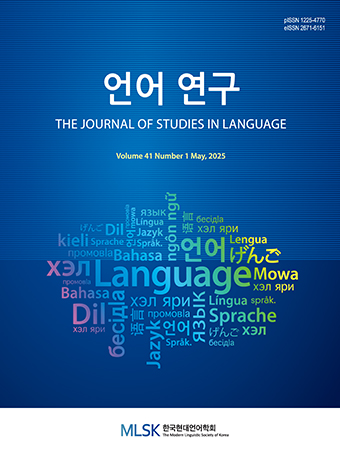Research Article
Abstract
References
Information
The current study aims to explore the model of team-teaching based on the flipped learning class in an English linguistics class. Also, the study plans to investigate the EFL learners’ overall perceptions toward the flipped learning class. The data were collected from various sources to ensure the reliability of the study. The following were elicited from the current study. First, flipped learning courses can be divided into three parts, including pre-activity, in-class activity, and post-activity. Second, it is important for instructors to offer various activities to foster learners’ participation. Third, instructors should consider students’ current linguistic levels when preparing pre-class activities.
- 김백희 ‧ 김병홍. 2014. 플립트 러닝(Flipped Learning)을 기반으로 한 역할 교체식토의 수업 방안 연구. 『우리말 연구』 37, 141-166.
- 김양희. 2015. 플립 러닝(flipped learning)을 활용한 대학 글쓰기 수업 운영 방안 연구. 『인문과학연구』 47.4, 323-352.
- 김용석. 2015. 대학 교양영어 수업에 거꾸로 수업(flipped class) 교수법 적용 후 정서적 경험, 학업성취도와 수업 만족도 측면에서의 효과. 『외국어교육』 22.1, 227-254.
- 임가나 ‧ 나경희. 2017. Flipped Learning 기법의 활용이 대학생의 영어 성취도와 수업 만족도에 미치는 영향. 『언어학연구』 44, 289-307.
- 변지현 ‧ 정규태. 2015. 거꾸로 교실을 적용한 영어과 교과 원격기반 토론 수업 사례 연구. 『현대언어연구』 31.3, 683-706.
- 서예은 ‧ 성귀복. 2015. 협동학습 기반의 Flipped Learning 모델 활용 수업이 영어성취도 및 태도에 미치는 영향. 『영어학』 15.4, 765-792.
- 서정목. 2015. 플립러닝을 활용한 영어교과목의 융복합적인 운영에 관한 연구-스크린영어, SNS영어 및 TED영어를 중심으로. 『교양교육연구』 9.3, 193-214.
- 이동엽. 2013. 플립드러닝(Flipped Learning) 교수학습 설계모형 탐구. 『디지털융복합연구』 11.2, 83-92.
- 전희옥. 2014. 사회과 거꾸로 교실 수업 모형 개발. 『사회과교육연구』 21.4, 51-70.
- Bergmann, J. and Sams, A. 2012. Flip Your Classroom: Reach Every Student in Every Class Every Day. Alexandria: ASCD.
- Bergmann, J. and Sams, A. 2014. Flipped Learning: Gateway to Student Engagement. Washington DC: International Society for Technology in Education.
- Cho, H.M., O.N. Kwon., and J.E. Yoon. 2016. Analyzing Students’ Engagement Factors in Flipped Mathematics Class. The Mathematical Education 55.3, 299-316. 10.7468/mathedu.2016.55.3.299
- Creswell, J.W. 1994. Research Design: Qualitative and Quantitative Approaches. Thousand Oaks, CA: Sage.
- Kang, J. 2015. The Perception of Elementary School Teachers on Flipped Learning for Elementary English instruction. Primary English Education 21.3, 51-78.
- Kang, N.H. and M.R. Ahn. 2015. Flipping a Korean university EFL Classroom with Teacher-crafted Youtube Videos. STEM Journal 16.3, 109-134. 10.16875/stem.2015.16.3.109
- Kim, Y.S. 2015. The Effect of the Flipped Class on the Affective Experience, Learning Achievement, and Class Satisfaction of College Language Learners. The Korea Association of Foreign Language Education 22.1, 227-254.10.15334/FLE.2015.22.1.227
- Lakmal, A. and D. Phillip. 2015. Motivation and Cognitive Load in the Flipped Classroom: Definition, Rationale and a Call for Research. Higher Education Research & Development 34.1, 1-14.10.1080/07294360.2014.934336
- Park, T.J. and Cha, H.J. 2015. Investigation of Teachers’ Awareness of Flipped Classroom to Explore Its Educational Feasibility. The Journal of Korean Computer Education 18.2, 81-97.
- Strayer, J.F. 2012. How Learning in an Inverted Classroom Influences Cooperation, Innovation and Task Orientation. Learning Environment Research 15.2, 171-193.10.1007/s10984-012-9108-4
- Publisher :The Modern Linguistic Society of Korea
- Publisher(Ko) :한국현대언어학회
- Journal Title :The Journal of Studies in Language
- Journal Title(Ko) :언어연구
- Volume : 35
- No :1
- Pages :7-21
- DOI :https://doi.org/10.18627/jslg.35.1.201902.7




 The Journal of Studies in Language
The Journal of Studies in Language






